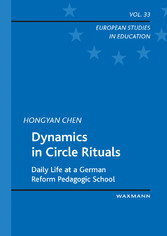Suchen und Finden
Service
Book Cover
1
Acknowledgements
5
Table of Contents
7
Abstract
11
1. Introduction
13
1.1 The Morning Circle in Academic Discussion
14
1.2 Ritual as the Framework of Circle Analysis
16
1.3.1 Beyond the Talking Circle
24
1.3.2 Order and Power in the Playful Morning Circle
26
1.3.3 Qualitative versus Quantitative Research
28
1.3 Stating Questions
22
1.3.1 Beyond the Talking Circle
24
1.3.2 Order and Power in the Playful Morning Circle
26
1.3.3 Qualitative versus Quantitative Research
28
1.4 Structure of this Research
29
2. The Morning Circle as Ritual Performance
33
2.1 Ritual as a Dynamic Process: The Transformation of Ritual Study
34
2.1.1 Ritual as an Academic Discourse: From Myth to Social Practice
34
2.1.2 Towards a Dynamic Ritual: Ritual as a Performance Process
38
2.1.2.1 Ritual as the Performing and Transmission of Cultural Heritage
38
2.1.2.2 Ritual as the Constructing and Performing of Social Institutions
40
2.2 The Morning Circle as Theatrical Ritual Performance
42
2.2.1 The Morning Circle as Performative Ritual
43
2.2.2 Make a Difference: The Ludic Element of the Morning Circle
46
2.3 Body and Mimesis
49
2.3.1 Paralanguage: The Body as an Anthropological Topic
49
2.3.2 The Unnatural Body
51
2.3.3 The Creative Body: Body and Mimesis
52
2.3.4 Gesture: Language of the Body
54
Chapter Summary
56
3. Methodology and Methods
58
3.1 Participant Observation as Performing Ethnography
58
3.1.1 Problems of Participant Observation
58
3.1.2 Participant Observation as Performative Process
62
3.1.2.1 Phase One
62
3.1.2.2 Phase Two
64
3.1.2.3 Phase Three
65
3.2 Videography in the Classroom: How Kids Play with the Camera
66
3.3 An Analytical Tool: Documentary Methods of Video-Interpretation
67
3.3.1 Documentary Methods
68
3.3.2 The Application of Documentary Method in this Study
70
3.3.2.1 Two Provisos: Conjunctive Experience and the Double Structure of the Body
70
3.3.2.2 Performativity in Video: Dimensions of Video Analysis
71
Chapter Summary
73
4. The School Field: Creating a Communicative Living Space
74
4.1 The School as a Building
74
4.1.1 The School in the City
74
4.1.2 The Internal Structure of the School
75
4.1.3 The Playground
77
4.1.4 School as a Communicative Social Space
78
4.2 The School Profile: The School as a Community
79
4.2.1 The School Reform in Process: The Way to a Community
79
4.2.2 The Incongruence of Space and Culture
81
4.3 A Routine Day: We are a Jena-Plan School now
82
4.3.1 The Rhythm of a Routine School Day
82
4.3.2 Heterogeneous Children in a Homogenous School Setting
84
4.3.3 Teacher as Nurturer vs. Teacher as Pedagogue
86
4.3.4 Parents as Participants
87
4.4 An Analysis Unit: Introduction to Class X
88
Chapter Summary
90
5. A Sketch of the Morning Circle: Performance in the Circle
91
5.1 Prologue: The Morning Circle as Routine Performance
92
5.2 Preparation: The Classroom as a Dynamic, Interactive Space
93
5.2.1 The Mobility of the Chairs: The Construction of the Classroom
95
5.2.2 The Creating of Scenes: Forming a Positive Atmosphere
97
5.3 Staging and Performance: Everything is in Order
99
5.3.1 Organization of Space: Let’s sit in a Circle
100
5.3.2 Organization of Time: Time Sequences as Structured Time Shaping
101
5.3.3 Dramatic Transition: From Chaos to Silence
104
5.3.4 Body Movement in the Circle
105
5.3.4.1 Sitting as Basic Form
106
5.3.4.2 The Preeminence of Hands
107
5.3.4.3 Facial Expressions: Glancing and Gazing
109
5.3.4.4 Communicative Body
110
5.3.5 Language
110
5.3.5.1 The Art of Speaking
111
5.3.5.2 Speech Act(s): Das ist aber schön!
113
5.3.5.3 Communicative Language in the Circle
115
5.4 The Ending: Informal Parting of the Morning Circle
116
Chapter Summary
117
6. The Reconstruction of the Scenes: On Orders and the Ludic
119
6.1 Meta-Communicative Framework: Making an Acquaintanceship
120
6.1.1 The Circle as a Natural Form: Performativity of the Circle
121
6.1.2 Greeting and Parting Rituals
123
6.2 Establishing Order
126
6.2.1 Cyclic Time in the Morning Circle
127
6.2.2 The Circle Space as an Active Zone
130
6.2.3 Civilization in the Practice of Order
133
6.2.3.1 Framing the Professional Schooling Posture
133
6.2.3.2 Talkativeness as Main Criterion of Competence
137
6.2.4 A Disorderly Moment as Promoter of Readjusting
140
6.2.5 Spoilsports: Who Breaks the Rules and Who Deserves to be Punished
145
6.2.6 Under the Auspices of Order
149
6.3 The Ludic Morning Circle: Power In-Between
149
6.3.1 Have Fun!
150
6.3.2 Gender as Game: Between Playful and Serious
153
Chapter Summary
155
7. Discussion
157
7.1 Magic Circle Rituals as a Basic Framework of Modern School Practice
157
7.2 Rethinking Method and Methodology
162
Bibliography
165
Appendix: Transcription Key
175
Alle Preise verstehen sich inklusive der gesetzlichen MwSt.








